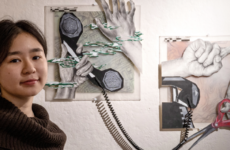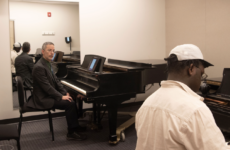With my time left in China now down to one week, I can surely say that I’ve observed a large difference in Chinese culture as it relates to the arts. Entering my term abroad, the extent to which I expected modern China, especially Beijing, to resemble Western art culture has completely proven false. I’ve been exposed to a wide array of more traditional Chinese art — from the fashion trends of the Tang Dynasty to the architecture of the Forbidden City to the paintings in the Huxian Peasant Painting Studios. I’ve been able to absorb a range of art culture that is not apparent in the US.
While school taught me about China and foreign influences throughout its dynasties, I observed a common theme: China’s capacity to retain their traditions and cultures despite needing to compete with Western powers. China’s ability to avoid succumbing to Western pressures and influences permeates Chinese art and architecture and never ceases to amaze me. In my eyes, the resemblance between China and America is scarce to none.
I’ve had the opportunity to try Chinese calligraphy as well as Chinese linear art through my art class at school. But aside from classes, what my eyes have taken in serve almost as another class with endless knowledge to be absorbed. I’ve seen paintings of Mao with civilians bowing at his feet, others of landscapes infused with the color red — a symbol of luck. I even bought a small, colorful painting from an artist in Xi’an, which depicts many school children heading home after classes. I’ve noticed that many works either represent the Chinese way of life or beautiful landscapes, which both give way to ultimately what Chinese culture values.
My many subway rides, bus rides, and trips to various malls never fail to keep me up to date with the current fashion trends. In terms of this genre of art, I’ve noticed high-end luxury brands ranging from stores like Louis Vuitton to Supreme to Ferragamo. At the same time, however, with this demand for high-end clothing, I have seen a large amount of knock-off items. Just the other day I saw a young man wearing a shirt emblazoned not with Calvin Klein but Calvin Klien.
What I’ve found most interesting, though, is the variety of architecture I’ve been able to see. Each morning on my ride to school I pass some of the top architecture marvels in the world, such as the Bird’s Nest, CCTV Tower, and the Water Cube. In my trip to Shanghai I was able to see other amazing buildings like the Shanghai World Financial Center and all the buildings around The Bund. While my study-abroad experience has placed me alongside some of the greatest architecture in the world, I’ve also been exposed to the average apartments of common working families. This showed me an aspect of China that I might not have recognized if I had simply visited a couple of days. Furthermore, everyday after school I walk by various banks, printing shops, hutongs (old Chinese streets), and markets that feature the common Chinese architecture made mainly of timberwork and beams covered in carvings and paintings.




